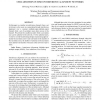Free Online Productivity Tools
i2Speak
i2Symbol
i2OCR
iTex2Img
iWeb2Print
iWeb2Shot
i2Type
iPdf2Split
iPdf2Merge
i2Bopomofo
i2Arabic
i2Style
i2Image
i2PDF
iLatex2Rtf
Sci2ools
ICASSP
2011
IEEE
2011
IEEE
User admission in MIMO interference alignment networks
In this paper we consider an interference channel where a set of primary active users are cooperating through interference alignment over a constant multiple-input-multiple-output channel while a set of secondary users desire access to the channel. We present the conditions under which a secondary user can be admitted to the network. For the admitted users, we derive several beamforming designs maximizing approximately the secondary users’ sum-rate based on the number of the secondary users, the number of antennas at the secondary users and the total number of streams in the network of active users.
| Added | 21 Aug 2011 |
| Updated | 21 Aug 2011 |
| Type | Journal |
| Year | 2011 |
| Where | ICASSP |
| Authors | Behrang Nosrat-Makouei, Jeffrey G. Andrews, Robert W. Heath Jr. |
Comments (0)

